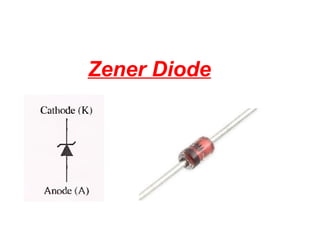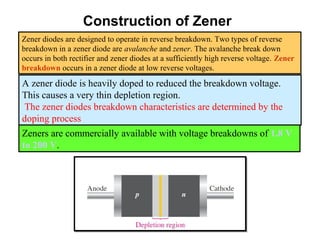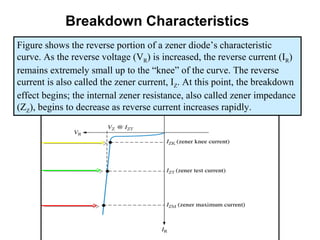Zenerdiode
- 1. Zener Diode
- 2. Outlines Introduction of Zener Diode Construction of Zener Diode Working of Zener Diode Application of Zener Diode Numerical of Zener Diode
- 3. Introduction The zener diode is a silicon pn junction devices that differs from rectifier diodes because it is designed for operation in the reverse-breakdown region. The breakdown voltage of a zener diode is set by carefully controlling the level during manufacture. The basic function of zener diode is to maintain a specific voltage across it’s terminals within given limits of line or load change. Typically it is used for providing a stable reference voltage for use in power supplies and other equipment.
- 4. Construction of Zener Zener diodes are designed to operate in reverse breakdown. Two types of reverse breakdown in a zener diode are avalanche and zener. The avalanche break down occurs in both rectifier and zener diodes at a sufficiently high reverse voltage. Zener breakdown occurs in a zener diode at low reverse voltages. A zener diode is heavily doped to reduced the breakdown voltage. This causes a very thin depletion region. The zener diodes breakdown characteristics are determined by the doping process Zeners are commercially available with voltage breakdowns of 1.8 V to 200 V.
- 5. Working of Zener A zener diode is much like a normal diode. The exception being is that it is placed in the circuit in reverse bias and operates in reverse breakdown. This typical characteristic curve illustrates the operating range for a zener. Note that it’s forward characteristics are just like a normal diode.
- 6. Breakdown Characteristics Figure shows the reverse portion of a zener diode’s characteristic curve. As the reverse voltage (VR) is increased, the reverse current (IR) remains extremely small up to the “knee” of the curve. The reverse current is also called the zener current, IZ. At this point, the breakdown effect begins; the internal zener resistance, also called zener impedance (ZZ), begins to decrease as reverse current increases rapidly.
- 7. ZENER BREAKDOWN • Zener and avalanche effects are responsible for such a dramatic increase in the value of current at the breakdown voltage. • If the impurity concentration is very high, then the width of depletion region is very less. Less width of depletion region will cause high intensity of electric field to develop in the depletion region at low voltages.
- 8. • Lets take an example to understand things clearly. • Let say the width of depletion region is 200 Å (very small). If a reverse bias voltage of just 4 V is applied to the diode, then the electric field intensity in the depletion region will be 4 = 2 x 108 V/m 200 x 10-10
- 9. . • Merely a voltage of 4 V is responsible to generate an electric field intensity of 2 x 108 V/m (very high intensity). • This electric field is sufficient to rupture the bonds and separate the valence electrons from their respective nuclei. • Large number of electrons gets separated from their atoms, resulting in sudden increase in the value of reverse current. • This explanation was given by scientist C. E. Zener. Such diodes are called Zener diodes. • Zener effect predominates in diodes whose breakdown voltage is below 6 V.
- 10. AVALANCHE BEAKDOWN • Zener effect predominates on diodes whose breakdown voltage is below 6 V. The breakdown voltage can be obtained at a large value by reducing the concentration of impurity atom. • We know that very little amount of current flows in the reverse biased diode. This current is due to the flow of minority charge carriers i.e., electrons in the p type semiconductor and holes in the n type semiconductor.
- 11. . • The width of depletion region is large when the impurity concentration is less. • When a reverse bias voltage is applied across the terminals of the diode, the electrons from the p type material and holes from the n-type materials accelerates through the depletion region. • This results in collision of intrinsic particles (electrons and holes) with the bound electrons in the depletion region. With the increase in reverse bias voltage the acceleration of electrons and holes also increases. • Now the intrinsic particles collides with bound electrons with enough energy to break its covalent bond and create an electron-hole pair. This is shown in the figure.
- 13. . • The collision of electrons with the atom creates an electron-hole pair. • This newly created electron also gets accelerated due to electric field and breaks many more covalent bond to further create more electron-hole pair. • This process keeps on repeating and it is called carrier multiplication. • The newly created electrons and holes contribute to the rise in reverse current. • The process of carrier multiplication occurs very quickly and in very large numbers that there is apparently an avalanche of charge carriers. Thus the breakdown is called avalanche breakdown.
- 14. DIFFERENCE BETWEEN ZENER AND AVALANCHE BREAKDOWN Zener Breakdown 1.This occurs at junctions which being heavily doped have narrow depletion layers 2. This breakdown voltage sets a very strong electric field across this narrow layer. 3. Here electric field is very strong to rupture the covalent bonds thereby generating electron-hole pairs. So even a small increase in reverse voltage is capable of producing Large number of current carriers. 4. Zener diode exhibits negative temp: coefficient. Ie. breakdown voltage decreases as temperature increases. Avalanche breakdown 1. This occurs at junctions which being lightly doped have wide depletion layers. 2. Here electric field is not strong enough to produce Zener breakdown. 3. Her minority carriers collide with semi conductor atoms in the depletion region, which breaks the covalent bonds and electron-hole pairs are generated. Newly generated charge carriers are accelerated by the electric field which results in more collision and generates avalanche of charge carriers. This results in avalanche breakdown. 4. Avalanche diodes exhibits positive temp: coefficient. i.e breakdown voltage increases with increase in temperature.
- 16. Zener diode Data Sheet Information VZ: zener voltage IZT: zener test current ZZT: zener Impedance IZK: zener knee current IZM: maximum zener current
- 17. Ideal Model & Ideal Characteristic Curve of Zener Diode
- 18. Practical Model & Ideal Characteristic Curve of Zener Diode
- 19. Zener Diode Applications – Zener Regulation with a Varying Input Voltage
- 20. Zener Limiting Zener diodes can used in ac applications to limit voltage swings to desired levels. VZ: zener voltage Vd: Diode voltage Vd = 0.7
- 21. Numerical of Zener Diode
- 22. A zener diode exhibits a certain change in V z for a certain change in lz on a portion of the linear characteristic curve between IZK and IZM as illustrated in Figure. What is the zener impedance?
- 23. Temperature Coefficient • The temperature coefficient specifies the percent change in zener voltage for each degree centigrade change in temperature. • For example, a 12 V zener diode with a positive temperature coefficient of 0.01% /O C will exhibit a 1.2 mV increase in Vz when the junction temperature increases one degree centigrade. • The formula for calculating the change in zener voltage for a given junction temperature change, for a specified temperature coefficient, is Where Vz is nominal zener voltage at 250 C. When temp. coefficient is expressed in mV/0 C
- 25. Example • A 5.0V stabilised power supply is required to be produced from a 12V DC power supply input source. The maximum power rating Pz of the zener diode is 2W. Using the zener regulator circuit calculate: a) The maximum current flowing through the zener diode. b) The value of the series resistor, Rs c) The load current IL if a load resistor of 1kΩ is connected across the Zener diode. d) The total supply current Is
- 26. (a) (b) (c) (d)
- 27. Zener Diode Voltages • As well as producing a single stabilised voltage output, zener diodes can also be connected together in series along with normal silicon signal diodes to produce a variety of different reference voltage output values • The values of the individual Zener diodes can be chosen to suit the application while the silicon diode will always drop about 0.6 - 0.7V in the forward bias condition. • The supply voltage, Vin must of course be higher than the largest output reference voltage
- 29. Summary • A zener diode is always operated in its reverse biased condition. • A voltage regulator circuit can be designed using a zener diode to maintain a constant DC output voltage across the load in spite of variations in the input voltage or changes in the load current. • The zener voltage regulator consists of a current limiting resistor Rs connected in series with the input voltage Vs with the zener diode connected in parallel with the load RL in this reverse biased condition. • The stabilized output voltage is always selected to be the same as the breakdown voltage Vz of the diode.





























